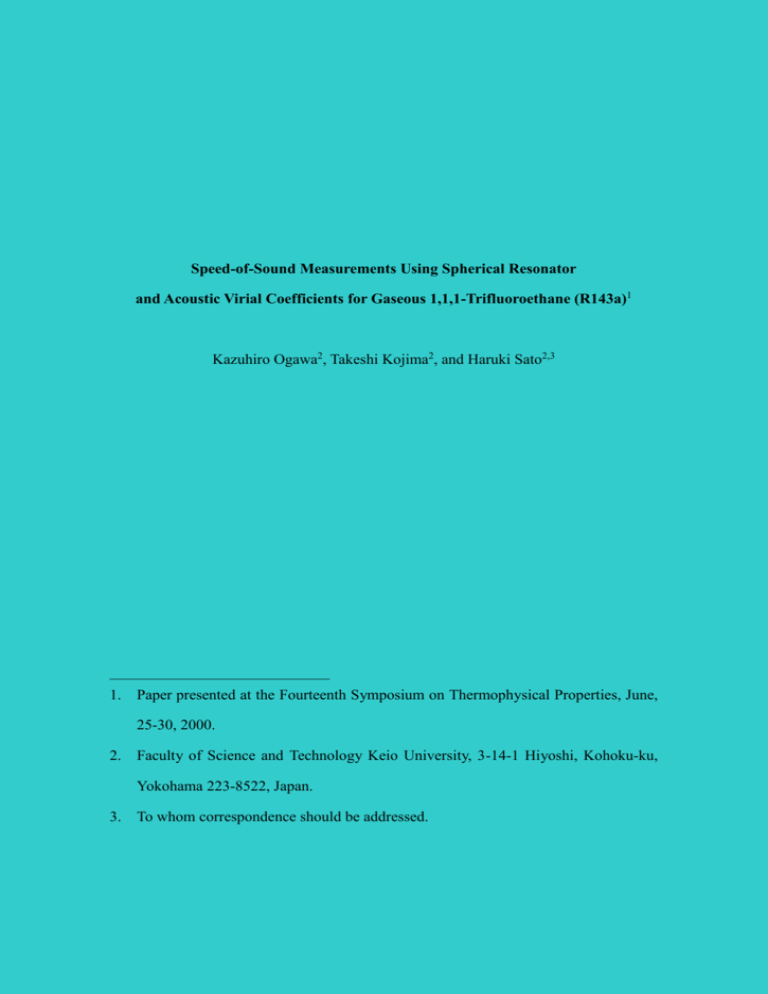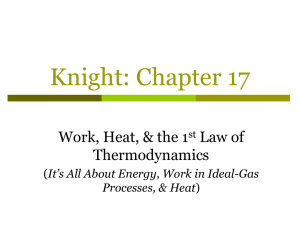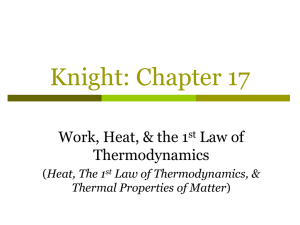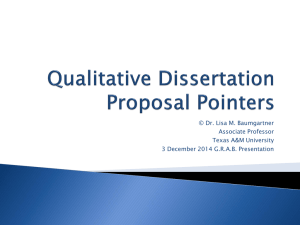Speed-of-Sound Measurements Using Spherical Resonator and
advertisement

Speed-of-Sound Measurements Using Spherical Resonator and Acoustic Virial Coefficients for Gaseous 1,1,1-Trifluoroethane (R143a)1 Kazuhiro Ogawa2, Takeshi Kojima2, and Haruki Sato2,3 1. Paper presented at the Fourteenth Symposium on Thermophysical Properties, June, 25-30, 2000. 2. Faculty of Science and Technology Keio University, 3-14-1 Hiyoshi, Kohoku-ku, Yokohama 223-8522, Japan. 3. To whom correspondence should be addressed. Abstract Speed-of-sound measurement with a spherical resonator is recognized as one of the most precise and reliable approach to determine ideal-gas heat-capacities and to reveal thermodynamic properties of rarefied gases. In this study, we applied a spherical resonator to measure the speed of sound in gaseous 1,1,1-trifluoroethane, R143a. Seventy speed-of-sound values were obtained along five isotherms from 303 K to 343 K and up to 500 kPa in pressure. In addition, cpo values and acoustic second virial coefficients were determined at each temperature of isotherm. Sample purity was 99.95 % of the gas-chromatograh area fraction analyzed by the manufacturer. The expanded uncertainties with k = 2 are estimated 8 mK in temperature, 0.2 kPa in pressure, and 72 ppm in speed of sound. We compared the cpo values determined from the measurements with those from theoretical calculation and confirmed the agreement between them within ±0.1 %. Key words: 1,1,1-trifluoroethane, acoustic virial coefficient, alternative refrigerant, ideal-gas heat-capacity, R143a, second virial coefficient, speed of sound, spherical resonator, virial equation of state 2 Introduction The speed-of-sound values in gaseous hydrofluorocarbon (HFC) refrigerants, not only pure refrigerants of R321, R152a2, R134a2,3, and R1254, but also the binary and ternary refrigerants of R32/134a5, R32/1256, R32/125/134a6, have been measured by using a spherical resonator in our group. The ideal-gas heat-capacity cpo was determined from the measurements for each pure refrigerant. On the other hand, the cpo can be determined from theoretical approach on the basis of the spectroscopic data. The theoretical cpo values of six HFC refrigerants, R23, R32, R125, R134a, R143a, and R152a, have also been calculated in our group, Yokozeki et al. 7 by completely independent approach from the experimental study. The coincidence between the experimental and theoretical cpo values would be the good evidence of the reliability. The experimental results for the speed of sound in R125 and R143a measured by former researchers in our group unfortunately do not satisfy this requirement. The measurements for R125 reported in a paper by Hozumi et al.8 and for R143a9 or R125/143a4 presented at academic conferences by Ichikawa et al. unfortunately do not agree with the theoretical values within 0.1 %. Those data differ from the theoretical results by several tenths percentage, so we do not recommend those data to be used. We took a long time for more than two years to find the reason why the difference between experimental and theoretical cpo values occurred. We did carefully examined uncertainty in measurements and also examined by Yokozeki regarding the mistakes in the theoretical calculations. Finally we found that the reason was not in the theoretical calculations but in the purity of the sample fluids and re-measured the speed of sound by using different sample fluid from that of previous measurement. New data were obtained using the sample fluid which has 99.95 area% purity of the gas-chromatograph area fraction analyzed by the manufacturer. The ideal-gas heat-capacity and the second acoustic-virial coefficient awere 3 finally determined for R143a from the speed-of-sound measurements in this study. Experimental Procedure An explanation of the experimental procedure was reported in the previous paper2. As illustrated in Figure 1, a pressure vessel, PV, and spherical resonator, SR, are immersed in silicon oil of heat transfer medium of a thermostat bath, sample gas was introduced into both of them. The inside and outside of the spherical resonator were filled with the common sample gas and its radius depends on only temperature. The sample fluid temperature was directly measured by a sheathed platinum resistance thermometer, PRT. The pressure was measured by digital quartz pressure gauge. After confirming a stable thermodynamic equilibrium condition, the frequency, amplitude, and phase difference were measured using a lock-in amplifier for the four different radially symmetric resonance modes of the sample gas in the spherical resonator. The speed of sound, W, was then determined from the values of the resonance frequency, fl, n, and half-width, gl, n, which were calculated from those measurements. The relation among W, fl, n, and gl, n is given by eq 1 which was derived and used by Ewing et al.10 in their data processing for spherical resonator measurements, f l,n igl, n W Zl, n f ig j 2a j (l=0, 1, 2, ...; n=0, 1, 2, ...) (1) where a is the radius of spherical resonator about 50 mm that is the linear function of temperature and Zl, n is the n-th root of the equation djl(z)/dz = 0 ; jl(z) is the l-th order spherical Bessel function. A certain mode is expressed by (l, n), while l=0 denotes radially symmetric mode. The second term on the right-hand side is a series of perturbation terms to represent various non-ideal conditions. Four radially symmetric resonance modes, (0, 2) through (0, 5), were used in the data processing. When a series of measurements was completed at a certain state point, we reduced the pressure very 4 carefully under the isothermal condition for the succeeding measurements at lower pressure and measured at fourteen different pressures along each isotherm between 303 K and 343 K. Result and Discussion The expanded uncertainties based on the ISO Guide (1993) in temperature, pressure, and speed-of-sound measurements are estimated being 8.0 mK, 0.2 kPa, and 72 ppm, respectively, where the coverage factor, k, is 2. The purity of the sample fluid analyzed by the manufacturer was better than 99.95 area% in the gas-chromatograph area fraction. No further purification except degas was conducted by the authors. Seventy speed-of-sound values in gaseous R143a were measured along five isotherms from 303 K to 343 K and at pressures from about 500 kPa down to 10 kPa as listed in Table 1. The listed data are the average values of the speed-of-sound measurements obtained for four different radially symmetric resonance modes from (0, 2) to (0, 5) at a certain state point. There is about 100 ppm difference among speed-of-sound values determined from the data at different modes as shown in Figure 2. This difference was considered to be caused by the roughness of the inner surface and distortion of the diameters being within ±50 m in total. From experiences of measurements for other substances, we used the average of the measurements for the four different modes. The thermophysical property values used in the perturbation terms of eq 1 for corrections to the measurements are, preliminary ideal-gas heat-capacity and a virial equation of state with provisional virial coefficients, the viscosity estimated by the group contribution method11 and the thermal conductivity estimated from the modified Eucken equation11. A contribution of the perturbation terms is estimated as being an order of magnitude of 100 ppm to speed-of-sound values and the combined standard 5 uncertainty due to these corrections was estimated as 10 ppm in the speed-of-sound values. The squared measured speed-of-sound data were correlated along each isotherm with the following quadratic function of pressure, 2 p p W 1 a a M RT RT 2 o RT (2) where denotes the ideal-gas specific-heat ratio; R is molar gas constant; M is the molar mass; and a is the second acoustic-virial coefficient, and a is the third acoustic-virial-like coefficient which works as a correction term of eq 2. We used the molar gas constant12 of 8.314472 Jmol-1K-1. The deviation of the experimental speed-of-sound values from eq 2 is shown in Figure 3. The base line in Figure 3 is the calculated results from eq 2. All measurements are well represented by eq 2 with the standard deviation of 7.5 ppm and within the maximum deviation of 26 ppm. The ideal-gas heat-capacity, cpo, and the a and a determined from the speed-of-sound measurements are listed in Tables 2 and 3, respectively. The cpo, and the a and a were simply determined from eq 2 at each temperature. The standard deviations of cpo, a, and a in the regression procedure of eq 2 to the squared speed-of-sound measurements are 0.033 %, 0.14 %, and 16 %, respectively. We compared the cpo values determined from the speed-of-sound measurements with those from theoretical calculation. The agreement between them was within ±0.1 % as shown in Figure 4. It should be noticed that the experimentally determined cpo values agree with theoretical calculation but it was measured after the theoretical calculation by Yokozeki et al.7 and they had correctly calculated cpo without experimental information. The cpo equation was developed on the basis of the theoretically derived values which is effective in the practically important temperature 6 range between 200 K and 500 K. cpo = 1.8567 + 10.14777 Tr –1.48667 Tr 2 –0.16996 Tr 3 (3) Tr = T / Tc , Tc = 345.860 K13 The base line of Figure 4 is calculated values from eq 3. The data reported by Ichikawa et al.9 were measured with the same spherical resonator but for different sample fluid in 1997. At the time we had not know the errors in measurements because our results were placed between the results reported by Beckermann and Kohler14 and the results by Gillis15. We had carefully examined the reason why our cpo values differ from theoretically determined values, while cpo for other HFC refrigerants determined from our measurements was coincident with the theoretical calculation by Yokozeki et al.7 within 0.1 %. Yokozeki had also tried to check his theoretical calculations for R143a several times with greatest care. In 1999 we had a chance to get new sample fluid produced by a different manufacture from the previous one. The purity was worse than before, but the results completely agree with those from theoretical calculations as shown by filled circles in Figure 4. We tried to check the reproducibility to measure the speed of sound using previous sample fluid at 343 K. The datum is shown as an open circle in Figure 4. The datum obtained using the previous sample fluid completely agrees with previous measurements shown by filled triangles in Figure 4. The a and a are shown Figures 5 and 6, respectively. The a and a values are in reasonably good agreement with those reported by Beckermann and Kohler14 and Gillis15. Conclusions Seventy speed-of-sound values were measured in gaseous 1,1,1-trifluoroethane, R143a, at temperatures between 303 K and 343 K and at pressures between 10 kPa and 508 kPa with expanded uncertainties (k=2) of 8 mK in temperature, 0.2 kPa in pressure, 7 and 72 ppm in speed of sound. Based on the speed-of-sound measurements, the second acoustic virial coefficient was determined. In addition, we could confirm the reliability of theoretical calculation of ideal-gas heat-capacity values for R143a by determining cp from the speed-of-sound measurements and developed the cp equation that is effective between 200 K and 500 K. The uncertainty was estimated within 0.1 %. Acknowledgments The authors thank the New Energy and Industrial Technology Development Organization, Tokyo, for the financial support of the present study. 8 Literature Cited 1. Hozumi, T.; Sato, H.; Watanabe, K. Speed of Sound in Gaseous Difluoromethane. J. Chem. Eng. Data 1994, 39, 493-495. 2. Hozumi, T.; Koga, T.; Sato, H.; Watanabe, K. Sound-Velocity Measurements for HFC-134a and HFC-152a with a Spherical Resonator. Int. J.Thermophys. 1993, 14, 739-762; Erratum, Int. J. Thermophys. 1994, 15, 385-386. 3. Hozumi, T.; Sato, H.; Watanabe, K. Speed-of-Sound Measurements and Ideal-Gas Heat Capacity for 1,1,1,2-Tetrafluoroethane and Difluoromethane. J. Chem. Eng. Data 1996, 41, 1187-1190. 4. Ichikawa, T.; Ogawa, K.; Sato, H.; Watanabe, K. Speed-of-Sound Measurements for Gaseous Pentafluoroethane and binary mixture of Pentafluoroethane + 1,1,1-Trifluoroethane. Proc. of the 5th Asian Thermophys. Prop. Conf. 1998, 535-538. 5. Hozumi, T.; Sato, H.; Watanabe, K. Speed-of-Sound Measurements in Gaseous Binary Refrigerant Mixtures of Difluoroethane (R-32) + 1,1,1,2-Tetrafluoroethane (R-134a). J. Chem. Eng. Data 1997, 42, 541-547. 6. Hozumi, T. Speed of Sound Measurements in the Gaseous Phase of Pure and Blended Refrigerants-Determination of Ideal-gas Heat-capacity and Second Virial Coefficient (in Japanese). Dissertation, Keio University: Yokohama, 1996. 7. Yokozeki, A.; Sato, H.; Watanabe, K. Ideal-Gas Heat Capacities and Virial Coefficients of HFC Refrigerants. Int. J. of Thermophys. 1998, 19, 89-127. 8. Hozumi, T.; Sato, H.; Watanabe, K. Ideal-Gas Specific Heat and Second Virial Coefficient of HFC-125 Based on Sound-Velocity Measurements. Int. J. Thermophys. 1996, 17, 587-595. 9. Ichikawa T.; Hozumi, T.; Sato, H., Watanabe, K. Speed-of-Sound Measurements for Gaseous 1,1,1-Trifluoroethane (R-143a). presented at the 13th Symposium on 9 Thermophys. Props. 1997. 10. Ewing, M. B.; McGlashan, M. L.; Trusler, J. P. M. The Temperature-Jump Effect and The Theory of The Thermal Boundary Layer for a Spherical Resonator. Metrologia 1986, 22, 93-102. 11.Reid, T. C.; Prausnitz, J. M.; Poling, B. E. The Properties of Gases & Liquids, 4th ed. McGraw-Hill: New York, 1987, pp.401-403 (viscosity); p.493 (thermal conductivity). 12. Taylor, B.N.; Mohr, P.J. CODATA Recommended Values of the Fundamental Physical Constants: 1988. J. Phys. Chem. Ref. Data, 1999, 28, 1713-1852; Rev. Modern Physics 2000, 72, 351-495. 13. Higashi, Y. and Okada, M. R407C, version 1. JARef Thermodynamic Tables, Vol. 3. JSRAE: Tokyo, 1997. 14. Beckermann, W.; Kohler, F. Acoustic Determination of Ideal-Gas Heat Capacity and Second Virial Coefficients of Some Refrigerants Between 250 and 420 K. Int. J. Thermophys. 1995, 16, 455-464. 15. Gillis, K. A. Thermodynamic Properties of Seven Gaseous Halogenated Hydrocarbons from Acoustic Measurements: CHClFCF3, CHF2CF3, CF3CH3, CHF2CH3, CF3CHFCHF2, CF3CH2CF3, and CHF2CF2CH2F Int. J. Thermophys. 1997, 18, 73-135. 16. TRC Thermodynamic Tables, Non-Hydrofluorocarbons, v-6881, 1989. Thermodynamic Research Center: Texas A&M University System, College Station, TX. 10 Table 1. Speed of Sound in R143a W / ms-1 303.143 K p / kPa W / ms-1 313.144 K p / kPa W / ms-1 323.133 K p / kPa 505.52 171.282 508.06 175.148 497.43 179.103 401.15 173.862 401.18 177.508 401.00 181.010 300.90 176.266 300.71 179.668 300.95 182.950 200.78 178.599 200.95 181.762 201.12 184.849 180.54 179.064 180.66 182.184 180.84 185.231 160.74 179.516 160.86 182.593 160.67 185.610 140.68 179.971 140.68 183.008 140.84 185.979 120.75 180.420 120.84 183.414 120.65 186.355 100.76 180.869 100.69 183.824 100.78 186.723 80.80 181.315 80.77 184.228 80.54 187.096 60.80 181.760 60.62 184.635 60.69 187.462 40.77 182.203 40.73 185.035 40.56 187.832 20.70 182.645 20.72 185.437 20.59 188.198 10.74 182.868 10.69 185.638 10.65 188.380 333.141 K 343.142 K 501.45 182.583 502.43 185.977 401.20 184.371 401.19 187.615 301.04 186.130 301.10 189.214 200.79 187.862 200.91 190.793 180.66 188.208 180.87 191.108 160.80 188.548 159.76 191.437 140.38 188.896 140.75 191.734 120.76 189.229 120.81 192.043 100.77 189.568 100.82 192.353 80.69 189.907 80.64 192.665 60.76 190.243 60.69 192.973 40.70 190.580 40.43 193.286 20.51 190.920 20.73 193.592 10.64 191.087 10.73 193.747 11 Table 2. Determined cpo Values for R143a Based on the Speed-of-Sound Measurements T/K cpo / R Uncertainty due to the fitting / % 303.143 9.487 0.033 313.144 9.704 0.028 323.133 9.903 0.025 333.141 10.098 0.025 343.142 10.295 0.029 Table 3. Second Acoustic-virial Coefficient, a and a of eq 2 for R143a T/K a / cm3mol-1 Uncertainty due to the fitting / % a / dm6mol-2 Uncertainty due to the fitting / % 303.143 -600.5 0.13 -0.111 3.4 313.144 -557.0 0.10 -0.082 3.5 323.133 -517.8 0.08 -0.059 3.5 333.141 -483.5 0.09 -0.036 6.6 343.142 -451.1 0.14 -0.022 16 12 Figure Captions Figure 1. Cross-section of spherical resonator and pressure vessel: T, Transducers; PRT, Platinum resistance thermometers; PV, Pressure vessel; SR, Spherical resonator. Figure 2. Difference among the speed-of-sound values obtained from different mode measurements: ●, (0, 2); ■, (0, 3); ◆, (0, 4); ▲, (0, 5). Figure 3. Deviation of the experimental speed-of-sound values from eq 2 : ○, 303K; △, 313K; □, 323K; ◇, 333K; +, 343 K. Figure 4. Deviations of Ideal-gas heat-capacity values of R143a measured by different researchers or theoretical calculations by Yokozeki et al.7 and by TRC16: ●, this work; ▲, Ichikawa et al.9; ○, This work; ◇, Yokozeki et al.7; +, Beckermann and Kohler14;□, Gillis15; ×, TRC16. Figure 5. Second acoustic virial coefficient of R143a: ●, this work; +, Beckermann and Kohler14; □, Gillis15. Figure 6. Third acoustic-virial-like coefficient,a, in eq 2: ● , this work; +, Beckermann and Kohler14; □, Gillis15. 13 Valve Assembly Sample Gas PRT T T 50 mm SR PV Figure 1. Cross-section of spherical resonator and pressure vessel: T, Transducers; PRT, Platinum resistance thermometers; PV, Pressure vessel; SR, Spherical resonator. 14 60 20 0 -20 6 10 (W mode-W ave) / W ave 40 -40 -60 -80 0 100 200 300 400 500 600 p / kPa Figure 2. Difference among the speed-of-sound values obtained from different mode measurements: ●, (0, 2); ■, (0, 3); ◆, (0, 4); ▲, (0, 5). 15 30 25 6 10 (W exp-W cal)/W cal 20 15 10 5 0 -5 -10 -15 -20 0 100 200 300 400 500 600 p / kPa Figure 3. Deviation of the experimental speed-of-sound values from eq 2: ○, 303K; △, 313K; □, 323K; ◇, 333K; +, 343 K. 16 1.0 0.8 100(cp o o o exp-cp cal)/cp cal 0.6 0.4 0.2 0.0 -0.2 -0.4 -0.6 200 250 300 350 400 450 500 T /K Figure 4. Deviations of Ideal-gas heat-capacity values of R143a measured by different researchers or theoretical calculations by Yokozeki et al. 7 and by TRC16: ●, this work; ▲, Ichikawa et al.9; ○, This work; ◇, Yokozeki et al.7; +, Beckermann and Kohler14;□, Gillis15; ×, TRC16. 17 -200 -300 3 a / m ・mol -1 -400 -500 -600 -700 -800 -900 -1000 200 250 300 350 400 450 T /K Figure 5. Second acoustic virial coefficient of R143a: ●, this work; +, Beckermann and Kohler14; □, Gillis15. 18 0.2 0.1 -0.1 -0.2 6 a / dm ・mol -2 0.0 -0.3 -0.4 -0.5 -0.6 -0.7 200 250 300 350 400 450 T /K Figure 6. Third acoustic-virial-like coefficient,a, in eq 2: ●, this work; +, Beckermann and Kohler14; □, Gillis15. 19








